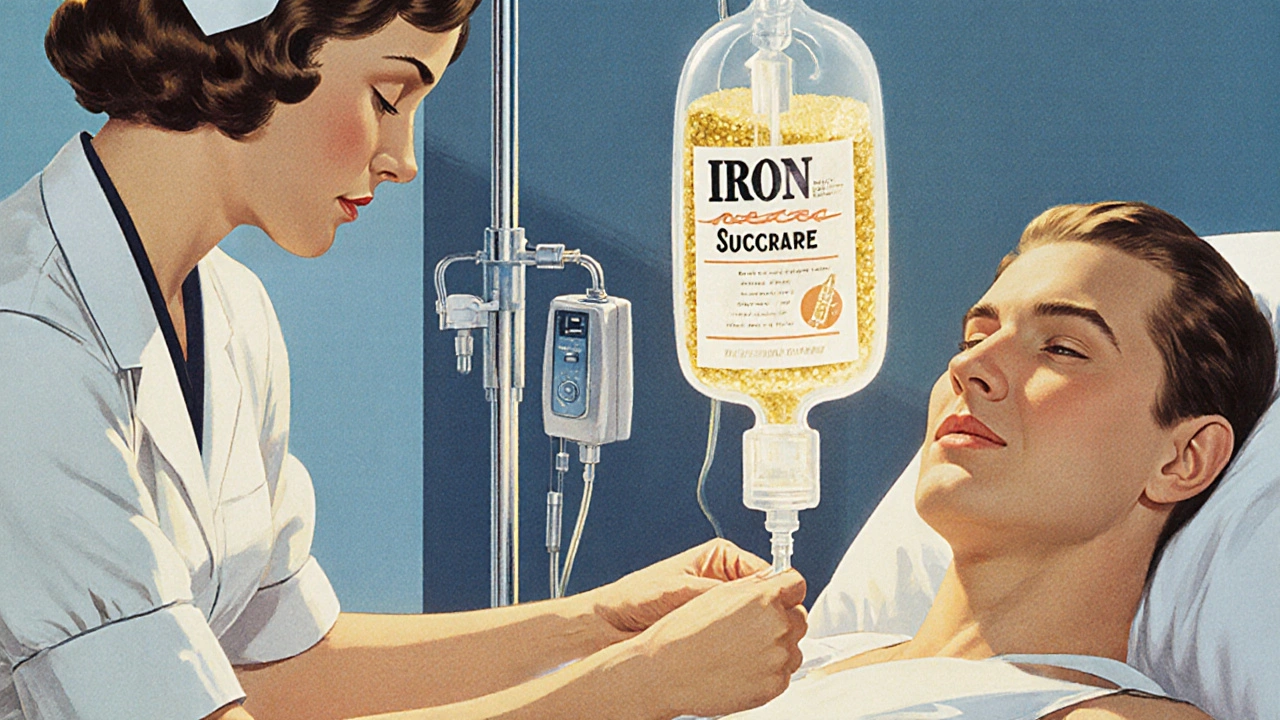When your kidneys aren’t working well, they don’t make enough of a hormone called erythropoietin. That hormone tells your bone marrow to make red blood cells. Without it, you get anemia-not just any anemia, but one that’s stubborn, hard to fix with simple iron pills, and often tied to fatigue so deep it feels like your body has been drained. This isn’t just about feeling tired. Left untreated, it raises your risk of heart problems, hospital stays, and even early death. For millions with chronic kidney disease (CKD), fixing this isn’t optional-it’s life-changing.
Why Anemia Happens in Kidney Disease
It’s not just about low erythropoietin. In CKD, the kidneys slowly lose their ability to produce this hormone. But there’s more going on. Inflammation from kidney damage triggers a protein called hepcidin, which blocks iron from moving out of storage and into your blood. Even if you have plenty of iron in your liver, your body can’t use it. That’s called functional iron deficiency. Add in poor diet, blood loss during dialysis, and vitamin B12 or folate shortages, and you’ve got a perfect storm.
Most people with stage 3 or worse CKD develop anemia. By stage 5, nearly 1 in 2 are affected. Hemoglobin levels below 12 g/dL in women and 13 g/dL in men are the clinical red flags. But here’s the catch: treating it isn’t as simple as taking an iron supplement. Oral iron? Often useless. Why? Because hepcidin shuts down absorption in the gut. Studies show only 30-40% of oral iron gets absorbed in CKD patients. That’s why doctors don’t start with pills-they start with IV iron.
Iron Therapy: Why IV Beats Oral
For patients on dialysis or with advanced CKD, intravenous iron is the standard. It bypasses the gut entirely. Iron sucrose, ferric carboxymaltose, and ferumoxytol are the most common forms. A typical dose for a hemodialysis patient? Around 400 mg monthly, unless ferritin levels are above 700 mcg/L or transferrin saturation (TSAT) is over 40%.
Why these numbers? Ferritin under 100 mcg/L means absolute iron deficiency-you need iron fast. Between 100 and 500 mcg/L with TSAT below 20-30%? That’s functional deficiency. You’ve got iron, but your body won’t use it. IV iron fixes both. Within 4 weeks, a 1,000 mg total IV dose can raise hemoglobin by about 1.5 g/dL. That’s faster than oral iron by months.
Side effects? Some people get a metallic taste, muscle cramps, or flu-like symptoms after the infusion. Rarely, there’s a serious allergic reaction-about 1 in 500 cases. But compared to the 40% of patients who get stomach pain, nausea, or constipation from oral iron, IV iron is far better tolerated. And for those on dialysis, it’s given during their session. No extra trips. No daily pills to forget.
Erythropoietin Therapy: The Hormone Replacement
Once iron levels are in range, doctors turn to erythropoiesis-stimulating agents (ESAs). These are synthetic versions of erythropoietin. Common ones include epoetin alfa, darbepoetin alfa, and biosimilars like Retacrit. They’re given either under the skin (subcutaneous) for non-dialysis patients or straight into the vein (IV) for those on dialysis.
How much? A typical starting dose for darbepoetin alfa is 0.45 mcg/kg once a week. For epoetin alfa, it’s 50-100 units/kg three times a week. Most patients see their hemoglobin rise by 1-2 g/dL within 2 to 6 weeks. But here’s the critical part: target hemoglobin levels.
For years, doctors tried to push hemoglobin above 12 g/dL, thinking more red cells meant more energy. But big studies like TREAT (2009) showed that pushing past 11.5 g/dL increases stroke risk by 32% and raises blood pressure. The result? Guidelines changed. The 2025 KDIGO guidelines now say: aim for 10-11.5 g/dL. Not 12. Not 13. Just enough to relieve fatigue and avoid transfusions.
Some patients still get pushed too high-22% of US dialysis patients, according to one JAMA study. Why? Old habits, pressure from patients feeling better, or misinterpretation of guidelines. But the evidence is clear: higher isn’t better. It’s riskier.

What If Iron and ESA Don’t Work?
About 1 in 10 patients don’t respond to ESA therapy. This is called ESA hyporesponsiveness. Common causes? Unfixed iron deficiency, ongoing inflammation, infection, or even aluminum toxicity from old dialysis fluids. Sometimes, it’s a combination. The fix? Double-check iron levels. Run a CRP test for inflammation. Rule out vitamin deficiencies. If iron is still low, increase IV iron. If inflammation is high, treat the root cause.
There’s also a new class of drugs: HIF-PH inhibitors. Roxadustat, daprodustat, and vadadustat are oral pills that trick your body into thinking it’s low on oxygen. That triggers natural erythropoietin production and improves iron use-all without injections. Roxadustat got FDA approval in December 2023 after safety reviews. Early data shows it works as well as ESAs, with fewer spikes in blood pressure and possibly better heart outcomes.
But it’s not perfect. There are concerns about tumor growth in patients with cancer history. That’s why it’s not for everyone. Still, for those who hate needles or struggle with IV access, it’s a game-changer.
Real Stories, Real Results
A 62-year-old man with diabetes and CKD had a hemoglobin of 8.2 g/dL. He couldn’t walk to the mailbox without gasping. After starting darbepoetin alfa weekly and IV iron sucrose 200 mg weekly, his hemoglobin climbed to 10.5 g/dL in 8 weeks. He started playing with his grandchildren again. No more naps after lunch. No more dizziness when standing up.
On the flip side, a 58-year-old woman on dialysis had her hemoglobin pushed to 12.8 g/dL to “feel better.” Three months later, she had a stroke. Her doctors had ignored the 11.5 g/dL ceiling. Her story isn’t rare.
Patients on forums like Reddit and DaVita report that 68% feel more energy within 4 weeks of starting ESA therapy. But 32% say their high blood pressure got worse. 25% report painful injection sites. IV iron? 45% say they taste metal afterward. But most say it’s worth it.

How Doctors Decide What to Do
There’s a clear step-by-step path now:
- Test hemoglobin. If below 12 g/dL (women) or 13 g/dL (men), check ferritin and TSAT.
- If ferritin is under 100 mcg/L or TSAT under 20%, start IV iron.
- Recheck hemoglobin in 4 weeks. If still below 10 g/dL and iron is adequate, start ESA.
- Adjust ESA dose every 4 weeks-up or down by 25%-based on how hemoglobin changes.
- Stop increasing ESA if hemoglobin rises more than 1 g/dL in 2 weeks. Don’t push past 11.5 g/dL.
- Monitor ferritin monthly. If it hits 800 mcg/L or higher, hold IV iron.
Doctors need to watch for ESA-induced hypertension. About 1 in 3 patients need stronger blood pressure meds after starting ESA. That’s normal. But if BP spikes suddenly or stays high, it’s a signal to lower the ESA dose.
The Big Picture: Where We’re Headed
The market for treating anemia in CKD is worth over $12 billion. ESAs still make up 75% of it. But HIF-PHIs are growing fast. By 2028, they could hit $3.5 billion. IV iron use has jumped from 48% in 2010 to 87% today. That’s because guidelines changed-and doctors finally listened.
What’s next? Personalized dosing using AI. Mayo Clinic is testing algorithms that predict how much ESA a patient needs based on weight, age, inflammation markers, and past response. Early results? 22% less variation in dosing. Fewer side effects. Better outcomes.
And the goal? No more fixed numbers. No more “11.5 g/dL for everyone.” The new focus is on symptoms. If you’re not tired, you don’t need a higher hemoglobin. If you’re exhausted, even 10.2 g/dL might be too low. Treatment is becoming as unique as the patient.
What Patients Should Know
If you have kidney disease and feel constantly tired, don’t brush it off. Ask for a hemoglobin test. Ask about your ferritin and TSAT. Don’t assume iron pills will fix it. Ask if IV iron is right for you. If you’re on ESA, know your target hemoglobin. Write it down. Ask your doctor: “Am I being pushed too high?”
Side effects happen. But they’re manageable. Hypertension? Adjust meds. Metallic taste? Drink water after the infusion. Injection pain? Rotate sites. The goal isn’t perfection-it’s feeling better without risking your heart.
And if you’re not improving? Push back. Ask why. Is your iron low? Is your inflammation high? Is your ESA dose right? You’re not just a number on a lab report. You’re a person who deserves to have energy, to live well, even with kidney disease.
Can I treat anemia in kidney disease with just iron pills?
No, not reliably. In chronic kidney disease, inflammation blocks iron absorption in the gut. Oral iron is poorly absorbed-only 30-40% gets into your blood. For most patients, especially those on dialysis, intravenous iron is the only effective way to correct iron deficiency. Iron pills might help in early-stage CKD, but once kidney function drops below 30%, IV iron is standard.
Why is my hemoglobin target 10-11.5 g/dL and not higher?
Because studies show that pushing hemoglobin above 11.5 g/dL increases the risk of stroke, heart attack, and blood clots. The TREAT trial found a 32% higher stroke risk when targeting 13 g/dL. While higher levels might make you feel more energetic, the dangers outweigh the benefits. Current guidelines from KDIGO and other major organizations recommend staying between 10 and 11.5 g/dL to balance symptom relief with safety.
What are the side effects of IV iron and ESAs?
IV iron can cause a metallic taste, muscle cramps, or flu-like symptoms in about 25-45% of patients. Rarely, it can trigger a serious allergic reaction (less than 0.2% of cases). ESAs commonly raise blood pressure-up to 30% of patients need stronger meds. Some report injection site pain or headaches. Both can cause iron overload if given too often or in too much. Regular monitoring of ferritin and TSAT keeps these risks low.
Is roxadustat better than erythropoietin injections?
It depends. Roxadustat is an oral pill that works by stimulating your body’s own erythropoietin and improving iron use. It’s easier to take than injections and may cause fewer spikes in blood pressure. But it’s not for everyone. It’s not recommended if you have active cancer, due to possible tumor growth risks. For patients without cancer and who dislike needles, it’s a strong alternative. For others, ESAs remain the first choice.
How often do I need blood tests?
Once you start treatment, check hemoglobin every 2-4 weeks until it stabilizes. Then, monthly. Ferritin and TSAT should be checked every 3 months if you’re on IV iron, or every month if your levels are unstable. If you’re on HIF-PHIs like roxadustat, your doctor may check labs more often at first to fine-tune the dose. Consistent monitoring is what keeps treatment safe and effective.
What if my anemia doesn’t improve after treatment?
If your hemoglobin doesn’t rise by at least 1 g/dL after 12 weeks of adequate iron and ESA therapy, you have ESA hyporesponsiveness. Common causes include ongoing inflammation, undiagnosed infection, vitamin B12 or folate deficiency, or aluminum toxicity. Your doctor should run a CRP test, check your vitamin levels, and review your dialysis history. Sometimes, switching from one ESA to another or adding more IV iron helps. In rare cases, a blood transfusion may be needed temporarily.




Scott Macfadyen
November 19 2025Just had my IV iron last week. Tasted like licking a battery, but I can actually walk to the fridge now without needing a nap. Worth it.